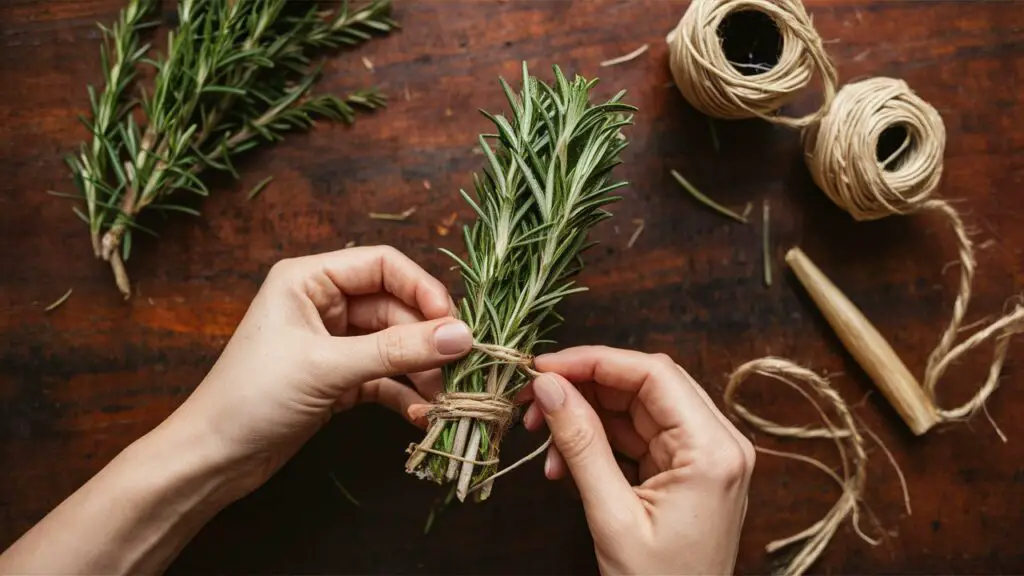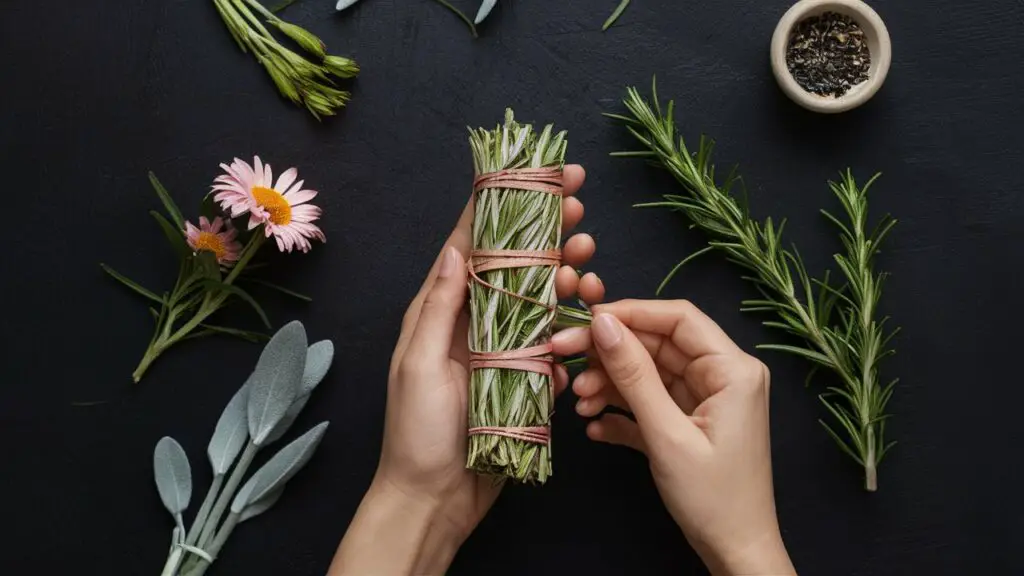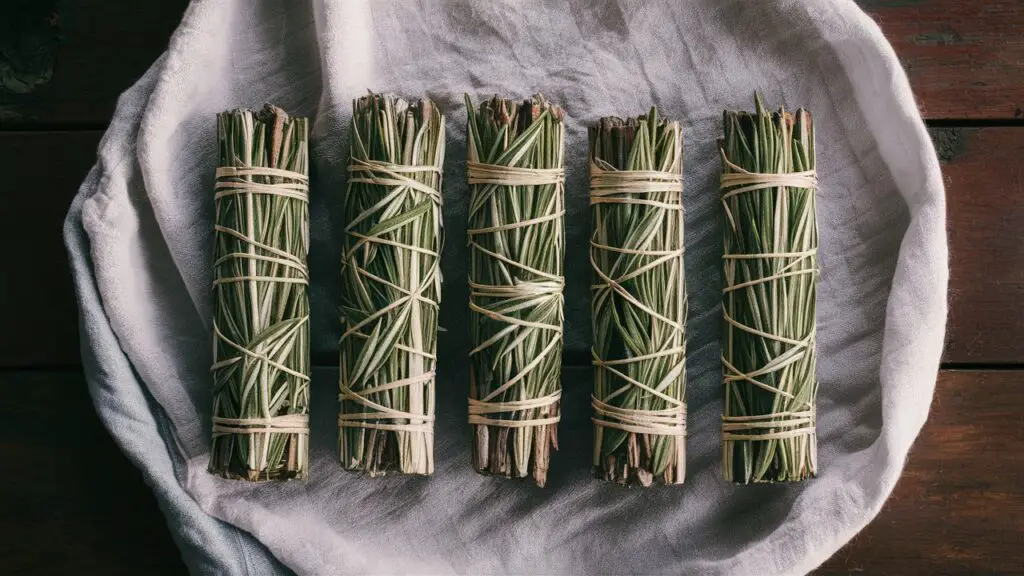How to Make a Rosemary Smudge Stick: A Step-by-Step Guide

Smudging is an ancient practice rooted in the spiritual traditions of various indigenous cultures. It involves burning herbs to cleanse and purify spaces, objects, or people. One aromatic herb that stands out in this tradition is rosemary.
Rosemary smudge sticks are cherished not only for their pleasant fragrance but also for their powerful cleansing properties. They are often used to clear negative energy, promoting a sense of peace and clarity. Using rosemary for purification can benefit both your mind and your environment, making it a versatile addition to any spiritual practice.
In this article, we will explore the benefits of using rosemary for smudging and provide you with a step-by-step guide on how to make your own rosemary smudge stick.
Do you have a specific interest in making rosemary smudge stick? Then use the table of contents below to jump to the most relevant section. And you can always go back by clicking on the black arrow in the right bottom corner of the page. Also, please note that some of the links in this article may be affiliate links. For more details, check the Disclosure section at the bottom of the page.
Here's what we'll cover:
Understanding Smudging: A Cultural Perspective
Smudging is a sacred practice in Native American culture. Indigenous tribes have been using smoke cleansing rituals for centuries to purify spaces and individuals, seeking spiritual protection and guidance. While each tribe has its own unique traditions, they all share a common element: the use of aromatic herbs and resins.
The Role of Herbs in Purification Rituals
Herbs play a crucial role in these purification rituals. Here are some key points about their significance:
- Rosemary, along with sage and cedar, is often used in these rituals due to its powerful cleansing properties.
- These plants are believed to drive away negative energies, promote healing, and invite positive vibes into the space.
- The cultural importance of smudging lies in its ability to connect practitioners with their ancestors, fostering a sense of unity and continuity.
Modern Applications and Interpretations
In today’s world, smudging has expanded beyond its traditional roots. People from different backgrounds now incorporate smoke cleansing into their spiritual practices in various ways:
- Home Cleansing: Clearing stagnant energy from living spaces.
- Personal Rituals: Purifying oneself before meditation or yoga.
- Ceremonial Use: Enhancing the sacredness of personal or group ceremonies.
This evolving practice shows a desire to honor ancient wisdom while adapting it to modern contexts. By using rosemary in smudging rituals, one taps into its historical essence while benefiting from its contemporary applications. This combination of tradition and innovation enriches our journey toward spiritual clarity and well-being.

The Power of Rosemary: Benefits for Your Mind and Space
Rosemary stands out among cleansing herbs due to its potent properties that address both physical and energetic spaces. Renowned for its ability to purify, rosemary’s aromatic essence creates a calming atmosphere, aiding in the removal of negative energies. This herb’s fresh and invigorating scent not only revitalizes the space but also enhances mental clarity.
Emotional and Spiritual Benefits
Engaging with rosemary during smudging rituals offers profound emotional and spiritual benefits:
- Mental Clarity: The aroma of rosemary is known to enhance concentration and memory, making it an excellent choice for study sessions or creative endeavors.
- Emotional Stability: Inhaling rosemary’s scent can help alleviate stress and anxiety, fostering a sense of inner peace.
- Spiritual Connection: Rosemary has long been associated with remembrance and fidelity, often used in rituals to connect with ancestors or loved ones.
Comparison with Other Popular Herbs
While sage and lavender are also popular aromatic herbs used in smudging, each has unique attributes:
- Sage: Known for its powerful cleansing properties, sage is often used to banish negative energies from spaces.
- Lavender: Celebrated for its soothing qualities, lavender is ideal for creating a tranquil environment conducive to relaxation and sleep.
Incorporating rosemary into your smudging practices not only diversifies your ritual experience but also brings specific benefits tailored to enhancing mental clarity and emotional well-being.
Gathering Your Materials: What You Need to Make a Rosemary Smudge Stick
Creating your own rosemary smudge stick requires a few simple materials, each chosen for its unique contribution to the process. Here’s what you’ll need:
Essential Materials
- Fresh Rosemary Sprigs: Gather around 8-10 sprigs of fresh rosemary. Look for healthy, vibrant green stems with plenty of fragrant needles. Fresh herbs for smudging ensure that your bundle will have the maximum potency and aroma.
- Natural Twine or Thread: Opt for 100% cotton thread or natural twine. These materials burn cleanly and maintain the integrity of your smudge stick. Avoid synthetic fibers, as they can produce harmful fumes when burned.

Optional Additions
To personalize your DIY smudge sticks, consider incorporating other herbs and flowers:
- Sage: Known for its strong cleansing properties, sage pairs well with rosemary.
- Lavender: Adds a calming aroma and enhances the spiritual benefits of your smudge stick.
- Rose Petals: Infuse your bundle with a lovely fragrance and aesthetic appeal.
Sourcing Natural Materials
The quality of your ingredients sets the foundation for an authentic experience. Always choose organically grown herbs and flowers if possible. When selecting binding materials, prioritize those made from natural fibers to ensure that your smudging practice remains pure and safe.
“Using fresh herbs in their most natural form connects you deeply with their inherent energies.”
Gathering these materials thoughtfully creates a harmonious blend that will elevate your smudging rituals to new heights.
Crafting Your Rosemary Smudge Stick: A Step-by-Step Guide
Step 1: Gather Materials
When learning how to make a rosemary smudge stick, the gathering process is the first and essential step. Each item you choose plays a crucial role in the effectiveness and authenticity of your smudging experience. One of the key ingredients for a rosemary smudge stick is, of course, fresh rosemary branches. You’ll also need some cotton string or twine to bind the smudge stick together. In addition to rosemary, you may also consider making your own cedar smudge stick for a different aromatic experience.
Materials Needed:
- Fresh Rosemary Sprigs: Aim for about 8-10 sprigs. Choose fresh, vibrant green sprigs that feel firm to the touch. This ensures your smudge stick will have potent aromatic properties.
- Binding Twine: Natural materials like 100% cotton thread or hemp twine work best. Avoid synthetic materials which can release harmful fumes when burned.
- Optional Herbs and Flowers: To personalize your smudge stick, you might include other herbs such as sage or lavender. These not only enhance the aroma but also bring additional properties to your smudging ritual.
Selecting Rosemary Sprigs:
Freshness is key. The sprigs should be free of any pesticides or chemicals. If possible, harvest from your garden or purchase from a trusted organic source.
Choosing the Right Binding Twine:
Opt for a material that burns cleanly. Cotton thread is commonly used due to its natural composition, ensuring no toxic chemicals are released during smudging.

Incorporating Other Elements:
If you wish to expand beyond just rosemary, consider adding:
- Sage: Known for its powerful cleansing properties.
- Lavender: Adds a soothing scent and calming energy.
- Flowers: Personal favorites like rose petals can add beauty and specific spiritual benefits.
By carefully selecting these materials, you set the foundation for making smudge sticks that are both effective and meaningful in your spiritual practices.
Step 2: Prepare the Bundle
Creating a harmonious and effective rosemary smudge stick begins with the careful arrangement of your rosemary sprigs. This step sets the foundation for your entire smudging experience.
1. Align the Sprigs
Start by laying out 8-10 sprigs of fresh rosemary. Ensure that the leafy ends are aligned, while the woody stems remain parallel. The uniformity in your arrangement contributes to a balanced and aesthetically pleasing bundle.
2. Incorporating Additional Herbs
If you plan on adding other herbs like sage or lavender, intersperse them evenly among the rosemary sprigs. This not only enhances the aroma but also amplifies the energetic properties of your smudge stick.
3. Layering Technique
For a more compact bundle, consider layering smaller sprigs on top of larger ones. This technique ensures that all parts of the bundle receive equal attention during smudging rituals.
Taking the time to thoughtfully arrange your herbs is an essential part of making smudge sticks. The care you put into this process will be reflected in the potency and beauty of your finished rosemary smudge stick.
Step 3: Cut the Twine
When learning how to make a rosemary smudge stick, determining the appropriate length of twine is crucial for ensuring your bundle stays secure.
1. Measure the Length
Measure out about three times the length of your rosemary sprigs. This extra length allows for wrapping and tying off the ends securely.
2. Choose the Right Material
Opt for natural materials like 100% cotton thread or hemp twine, which burn cleanly and add to the authenticity of your smudging experience.
Having the right amount of twine will facilitate a smooth binding process, making it an essential step in creating your smudge stick.

Step 4: Bind the Bundle
Creating a secure base is essential when learning how to make a rosemary smudge stick. Start by taking your neatly arranged rosemary sprigs and holding them firmly together at the bottom.
- Positioning the Twine: Place the twine or natural thread about an inch from the bottom of the bundle. This helps in creating a stable foundation.
- Initial Wrap: Begin wrapping the twine tightly around the base. Make sure each loop sits snugly against the previous one to prevent any loose ends. Keep wrapping until you’ve gone around several times and have a solid grip on the herbs.
- Securing the Base: Once you feel that the base is secure, tie a double knot with the remaining length of the twine. This ensures it won’t unravel during use or while drying.
Binding tightly not only holds your bundle together but also creates a sturdy starting point for wrapping up towards the top, which we’ll cover next.
Step 5: Wrap the Bundle
Wrapping the bundle securely ensures that your rosemary smudge stick stays intact during the drying process and use. To start, hold the base of your bundle firmly.
- Begin at the Bottom: Take your twine and start wrapping it tightly around the base, ensuring it’s snug but not cutting into the stems.
- Spiral Upwards: Gradually work your way up the length of the bundle in a spiral motion. Keep the twine evenly spaced to maintain a uniform look and secure hold.
- Tighten as You Go: As you wrap, gently pull on the twine to tighten it. This helps keep the sprigs together and prevents them from slipping out.
- Finish at the Top: Once you reach the top, loop the twine around a few times to secure it. You can also tie a small knot if needed.
This method of wrapping ensures that your bundle is both aesthetically pleasing and functional. With practice, you’ll find it easy to create a tight and secure smudge stick ready for drying.
Step 6: Finish Binding
To ensure your rosemary smudge stick is durable and secure, crisscross the twine at different angles. Start by wrapping the twine diagonally from the base to the top, then reverse direction to create a series of ‘X’ patterns along the bundle. This technique not only strengthens the structure but also adds an aesthetic touch.
Tip: Keep the twine taut during this step to maintain a firm hold on the herbs.
Reminder: Leave a small loop at the end for easy hanging during the drying process.
Careful binding ensures your smudge stick stays intact during use, making your spiritual practice more effective.

Step 7: Drying Process
Drying your rosemary smudge stick is a crucial step to ensure it burns effectively and releases its potent aroma. Fresh herbs contain moisture that can hinder the smoldering process, making thorough drying essential.
1. Hang the Bundle Upside Down
Find a sunny spot and hang your bundle upside down. This promotes even drying and prevents mold growth.
2. Drying Time
Allow approximately 2-3 weeks for the rosemary to dry completely. Patience in this stage enhances the herb’s aromatic properties.
The drying process transforms fresh sprigs into an effective tool for cleansing and purification rituals.
Using Your Rosemary Smudge Stick Effectively
Understanding how to make a rosemary smudge stick is just the beginning. Once your smudge stick is fully dried, it’s ready to be used in your cleansing rituals. Here’s how you can use it effectively:
1. Lighting the Smudge Stick
Hold the smudge stick at a slight angle and light the end with a match or lighter. Allow it to catch fire for a few seconds before gently blowing out the flame, leaving it to smolder and produce fragrant smoke.
2. Creating Sacred Smoke
As the smoke begins to rise, focus on your intention for the cleansing. You might want to say a prayer, mantra, or simply hold your intention in mind.
3. Cleansing Rituals
Move through your space with the smudge stick, allowing the smoke to reach every corner. Pay special attention to areas where energy feels stagnant or heavy. Wave the smudge stick gently, guiding the smoke with your hand or a feather.
4. Space Clearings
For larger spaces, walk in a clockwise direction while holding the smudge stick. Visualize any negative energy being transformed into positive energy by the purifying smoke.
5. Personal Cleansing
To cleanse yourself or another person, gently fan the smoke around your body from head to toe. Imagine any negativity being lifted away by the aromatic herbs.
Using these techniques ensures that your space and spirit are energetically clean and uplifted.
Caring For Your Rosemary Smudge Stick
To ensure your rosemary smudge stick remains effective, proper storage is key. After each session:
- Allow the stick to cool completely.
- Store it in a dry, cool place away from direct sunlight to preserve its potency.
- Place it in an airtight container or wrap it in a cloth to protect it from moisture.
If you have leftover pieces from previous sessions, keep them in a small jar or a resealable bag. This approach maintains their aromatic and energetic properties until you’re ready to use them again.
Sustainable Smudging Practices: Going Beyond Rosemary Sticks
Sustainability in herbalism practice is essential for both the environment and our spiritual journeys. Sourcing herbs responsibly ensures that we honor nature’s gifts and preserve them for future generations. Here are some tips to help you practice sustainable smudging:
1. Grow Your Own Herbs
Cultivating your own herb garden provides a direct and sustainable source for your smudge sticks. Herbs like sage, lavender, and rosemary can be grown in small garden plots or even pots.
2. Wildcrafting with Respect
If you choose to gather herbs from the wild, do so mindfully. Take only what you need, ensure the plant population remains healthy, and avoid over-harvesting. Always leave more than you take.
3. Support Ethical Suppliers
Purchase herbs from suppliers who prioritize sustainability. Look for certifications like organic or fair trade, which indicate environmentally friendly practices.
4. Explore Local Alternatives
Depending on your region, there may be local plants that offer similar benefits to traditional smudging herbs. Research native plants that can be used for cleansing and incorporate them into your rituals.
5. Reuse and Recycle
Use every part of the herb and recycle any leftovers. For example, leftover pieces can be added to potpourris or infused oils.
By integrating these sustainable practices into your herbalism routines, you not only enhance your connection to nature but also contribute to a healthier planet.
Thanks for the blog graphics: Canva.com
Disclosure: At Buddhatooth.com we only mention the products that we’ve researched and considered worthy. But it’s important to note that we are a participant of several affiliate programs, including but not limited to VigLink and Amazon Services LLC Associates Program, an affiliate advertising program designed to provide a mean for us to earn fees by linking to Amazon.com and affiliated sites. As an Amazon Associate Buddhatooth.com earns from qualifying purchases.

